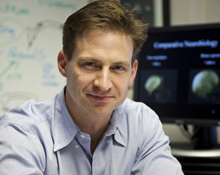People
February 8, 2010
Profile: Anthropologist maps evolution of neural circuitry

Jim Rilling
James Rilling entered the University of Wisconsin in Madison as a pre-med major, following in the footsteps of three older brothers who are physicians. But an evolutionary biology class changed his plans.
“I thought the course was so powerful,” says Rilling, associate professor of anthropology and the founder of Emory’s Laboratory for Darwinian Neuroscience. “All societies have had a need to understand their origins. But they’ve made up myths to explain it, while evolutionary biology is trying to get at the true story.”
Encouraged by his parents to pursue his passion, Rilling left the pre-med track to study the essence of human nature. “It’s like the space program,” he says. “We believe that we should be trying to understand the universe around us. I feel the same way about exploring the brain to learn who we are and how we got here.”
The Milwaukee native came to Emory as a graduate student, drawn by the anthropology department’s emphasis on human biology. “It’s a definite strength,” Rilling says, citing the department’s access to Yerkes National Primate Research Center, and the quality of the faculty.
For his dissertation, Rilling used functional magnetic resonance imaging (fMRI) to compare the neuroanatomy of humans and 10 other primate species at Yerkes. The 1998 study was the first in-depth look at whether the human brain is merely a scaled-up version of the brains of other primates.
“We found that human temporal lobes are larger than you would expect for a primate of our brain size,” Rilling says. “We’ve done subsequent work that shows this larger size is likely due to the evolution of language pathways in humans.”
The study also found that the human prefrontal cortex is more convoluted than expected. “One of the things that causes these cortical folds is when strongly connected areas of cortex get pulled together. That could be the neural basis for our ability to integrate lots of different types of information,” Rilling says, explaining that the prefrontal cortex is involved in functions like planning, decision-making, emotional regulation and working memory.
Rilling’s Laboratory for Darwinian Neuroscience is a leader in the use of non-invasive imaging technology to compare the neuroanatomy of living primates.
Much previous work has focused on the gray matter of brains. Rilling’s group is the only one in the world using diffusion tensor imaging (DTI) to compare the white matter connections of monkeys, humans and our closest relative, chimpanzees. White matter contains the fiber tracts that connect and “wire” the brain.
“We’ve discovered a difference in both the size and the trajectory of the fiber tract that runs between Wernicke’s area in the left temporal lobe and Broca’s area in the left inferior frontal cortex,” Rilling says. Broca’s area is involved in speech production and Wernicke’s in understanding language. In humans, the pathway that connects the two areas is much more massive, and projects beyond Wernicke’s area down to the ventral part of the temporal lobe.
“There’s something special going on in the human brain with that pathway,” Rilling says. “It’s organized differently than in other primates.”
The lab is also exploring the neural basis of human cognition and behavior. One of its studies showed that reciprocation in humans is tied to activation of a reward pathway in the brain. “The magnitude of that reaction correlated to how likely the person was to cooperate in the future,” Rilling says.
When you cooperate and someone else fails to reciprocate, activation is found in the anterior insula, a brain region known to track visceral responses of the body.
Why are some people more cooperative than others? How does the brain change with age? What promotes social bonding and attachment? These are just a few of the many research questions the lab is tackling.
“We want to start to understand individual human differences in social behavior, at both the genetic and neurological levels,” Rilling says. He adds that he’s particularly interested in understanding why some men are more nurturing as fathers than others.
“It’s important to have someone besides the mother involved in a child’s care. I think one way that we could improve childhood development is to have more committed dads,” says Rilling, who is married to a psychiatrist and hopes to one day become a father.
